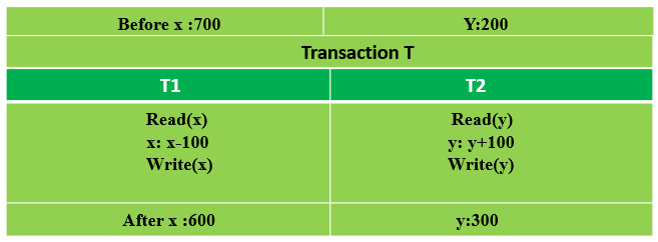ACID Properties of Transaction in Database
Transaction Processing is a model of computing, typically performed by large server computers, that supports interactive applications. Generally, in Transaction Processing, work is divided into individual, indivisible operations, known to be Transactions. Here we describe the ACID properties of the transaction in database management system.
It is defined as a group of tasks, a single task is the minimum processing unit which cannot be divided further and it is a small unit of a program and may contain several low-level tasks. In order to assure accuracy, a transaction in a database system must contain ACID – commonly called ACID properties.
ACID Properties of Transaction in DBMS
Why ACID Properties?
- A transaction is basically a group of tasks or you can also define it as a group of commands that change data stored in database.
- It is essential to ensure the accuracy, completeness and data integrity.
ACID Properties of Transactions
Atomicity
All changes to the data are preferred as if they are a single operation. All alterations to the data must be performed successfully or completely not at all. If any failure occurs during the middle of the transaction, then Roleback is the option. Simply, Transaction are all or nothing. There cannot be any partial execution. It involves two operations such as:
Abort: Changes made to the database are not visible when transaction aborts.
Commit: If a transaction commits, changes made will be visible.
Example is , an application that transfer funds from one account to another r, the atomicity property assures that, if a debit is made successfully from one account, the corresponding credit is made to other account.
Defining Example: Suppose if the transaction fails after the completion of T1 but before completion of T2. (say, after Write(X) but before Write(Y)), then amount has been deducted from X but not added to Y. This leads to inconsistent database state.
Therefore, in order to ensure the correctness of the database state, the transaction must be executed in entirety.
Consistency
Basically, the database is already consistent. But, we have to perform some operations such as Read, Write etc. But unaware of what will happens to consistency after performing the operations. Inorder to maintain the consistency, we have to check and ensure that the corresponding transaction is good working. Simply, Only valid data is saved.
The data must be in consistent state before and after the transaction. Once the transaction is executed, it should move from one consistent state to another after the corresponding execution.
Simple Example: An application that transfers funds from one account to another, the consistency property make assures that the total value of the funds in both the accounts is the same at the start and at end of the each transaction.
Defining Example: The total amount before and after the transaction must be maintained.
Total before T occurs= 700 + 200 = 900.
Total after T occurs = 600 + 300 = 900.
Therefore, the database is consistent here. If T1 completes but T2 fails, then an inconsistency occurs in this case. This results in incompletion of T.
Isolation
The execution of a transaction is not interrupted or affected by the execution of another transaction. Which means, transactions do not affect each other. So that, no other process can change the data while the transaction is running. Transactions must be executed in isolation from other transactions (No Locks).
The intermediate state of a transaction is usually invisible to other transactions. This results in the transactions that run concurrently appear to be serialized. During the concurrent execution of transaction, intermediate transaction results from simultaneously executed transactions should not be made available to each other. ( Level 0, 1,2,3 ).
Example, an application which transfers funds from one account to another, the isolation property ensures that another transaction views the transferred funds in one account or the other, but not in both, nor in neither.
Defining Example: Once T1 has been executed till Read (y) and then T2 starts. As a result of this, interleaving of operations takes place due to which T2 reads correct value of x but incorrect value of y and corresponding sum computed as:
T2: (X+Y = 50, 000 + 500=50,500) is thus not consistent with the sum at the end of transaction:
T1: (X+Y =50, 000 + 450=50, 450). This lead to database inconsistency, due to a loss of 50 units.
Hence, transactions must occur in isolation and changes should be visible only after they have been made to main memory.
Durability
After the successful completion of a transaction, if we make any update in the database should persist even in the case of system failures. Actually, the written data will not be lost. The alterations made by a transaction must persists.
Example, an application that transfers funds from one account to another, the durability property ensures that the changes made to each account will not be reversed.


